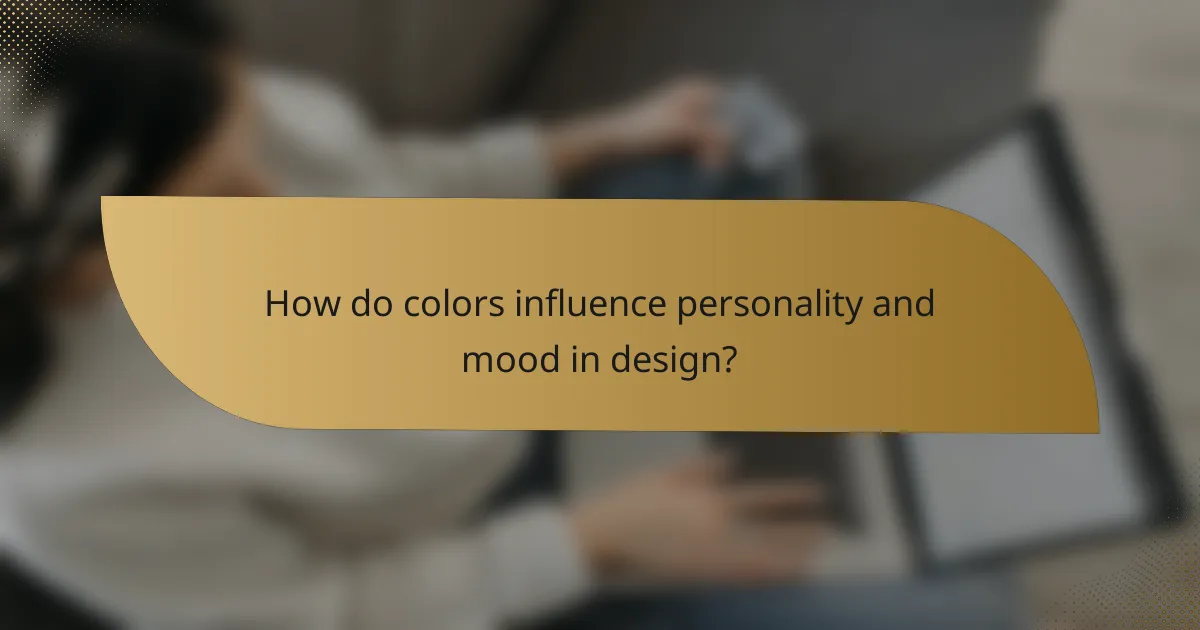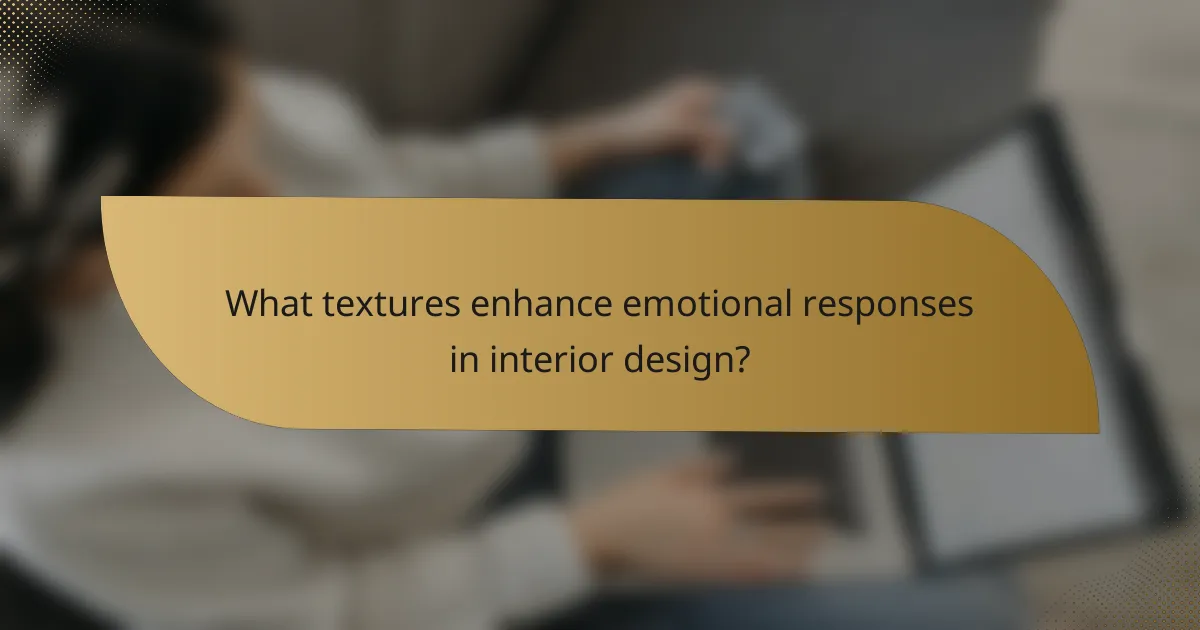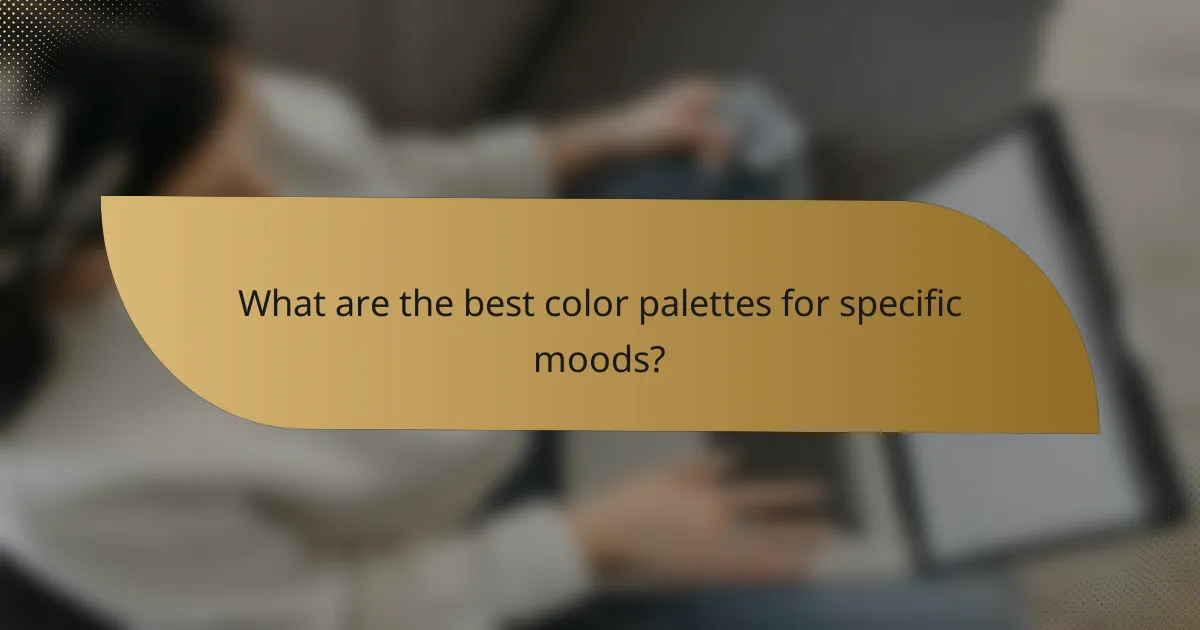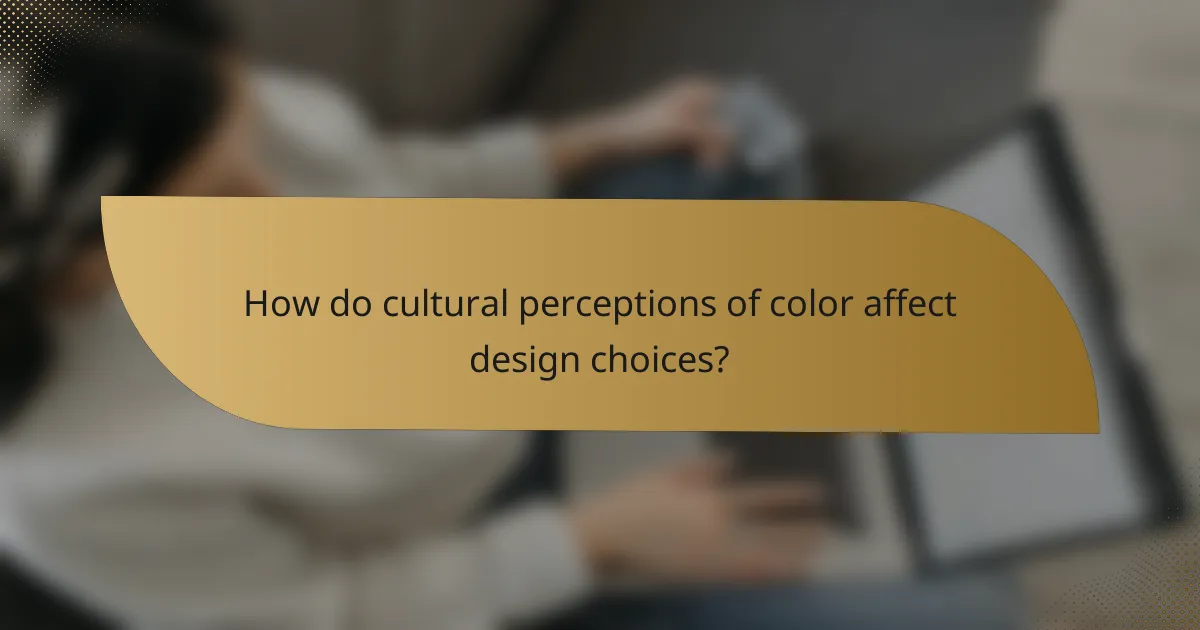Color and texture are powerful tools in design, significantly influencing personality and mood. By understanding how different colors evoke emotional responses and how textures shape the atmosphere, designers can create harmonious spaces that resonate with users. Thoughtful combinations of color and texture not only enhance aesthetics but also foster desired emotional experiences within a room.

How do colors influence personality and mood in design?
Colors play a significant role in influencing personality and mood in design by evoking specific emotional responses. Understanding how different colors affect feelings can help designers create spaces that align with desired atmospheres and user experiences.
Warm colors evoke energy and excitement
Warm colors, such as red, orange, and yellow, are known for their ability to stimulate and energize. These hues can create a sense of urgency or enthusiasm, making them ideal for environments where activity and interaction are encouraged, such as gyms or creative spaces.
When using warm colors, consider the intensity and saturation. Bright, vivid shades can be invigorating, while softer tones may provide a more inviting atmosphere. For example, a bright orange accent wall can energize a room, while a muted peach can create a cozy feel.
Cool colors promote calmness and tranquility
Cool colors like blue, green, and purple are associated with calmness and relaxation. These shades can help reduce stress and create a serene environment, making them suitable for spaces like bedrooms, offices, or wellness centers.
When incorporating cool colors, think about the context and lighting. Lighter shades can enhance a sense of openness, while darker hues may add depth and sophistication. A soft blue can make a small room feel larger, while a deep navy can create a cozy retreat.
Neutral colors provide balance and sophistication
Neutral colors, including whites, grays, and beiges, serve as a versatile backdrop that allows other colors to shine. They provide balance and can evoke feelings of sophistication and elegance, making them popular in modern design.
Using neutral colors effectively involves layering textures and materials to add interest. For instance, a gray sofa paired with colorful cushions can create a dynamic yet balanced look. Avoid overwhelming a space with too many neutrals; introduce accents to maintain visual appeal.

What textures enhance emotional responses in interior design?
Textures play a crucial role in shaping emotional responses in interior design by influencing the overall atmosphere of a space. Smooth and rough textures can evoke different feelings, making it essential to choose the right texture to align with the desired mood and functionality of the room.
Smooth textures create a modern, sleek feel
Smooth textures, such as glass, polished stone, and sleek metals, contribute to a contemporary aesthetic. These materials reflect light, making spaces feel larger and more open, which can promote feelings of calm and clarity. For example, a smooth marble countertop in a kitchen can create a sophisticated and clean environment.
When incorporating smooth textures, consider using them in high-traffic areas to enhance durability while maintaining a modern look. Avoid overly glossy finishes in spaces meant for relaxation, as they may create a sterile atmosphere rather than a welcoming one.
Rough textures add warmth and comfort
Rough textures, including wood, brick, and textiles like wool or linen, introduce a sense of warmth and coziness to interiors. These materials can evoke feelings of comfort and nostalgia, making them ideal for living rooms and bedrooms. For instance, exposed wooden beams or a brick accent wall can create an inviting and homey atmosphere.
To effectively use rough textures, balance them with smoother elements to avoid overwhelming the space. Mixing textures can enhance visual interest while maintaining a harmonious design. Be mindful of the color palette, as earthy tones often complement rough textures, reinforcing the warm and inviting feel.

How can color and texture combinations improve design harmony?
Color and texture combinations play a crucial role in achieving design harmony by creating a cohesive visual experience. When thoughtfully paired, they can evoke specific emotions and enhance the overall aesthetic of a space.
Complementary colors enhance visual appeal
Complementary colors, which are opposite each other on the color wheel, can significantly boost visual appeal by creating vibrant contrasts. For example, pairing blue with orange or red with green can draw attention and create a lively atmosphere. When using complementary colors, consider the balance; too much contrast can be overwhelming.
To effectively use complementary colors, start with a dominant hue and use its complement as an accent. This approach can help maintain a harmonious look while still providing visual interest. A good rule of thumb is to use approximately 60% of the dominant color and 30% of the complementary color, leaving 10% for neutrals.
Contrasting textures create dynamic spaces
Contrasting textures can add depth and interest to a design, making spaces feel more dynamic. For instance, combining smooth surfaces like glass with rough materials such as wood can create a striking visual contrast that engages the senses. This interplay can also affect how light interacts with the surfaces, enhancing the overall ambiance.
When incorporating contrasting textures, aim for a balance that prevents the space from feeling chaotic. A practical approach is to mix one or two bold textures with more subdued ones. For example, pair a plush velvet sofa with sleek metal accents to create a sophisticated yet inviting environment.

What are the best color palettes for specific moods?
The best color palettes for specific moods can significantly influence how a space feels and how individuals respond emotionally. Choosing the right colors involves understanding the psychological effects of hues and their combinations to create desired atmospheres.
Serene palettes for relaxation spaces
Serene color palettes typically include soft blues, greens, and neutral tones that promote calmness and tranquility. These colors can help reduce stress and create a peaceful environment, making them ideal for bedrooms, meditation areas, or spas.
When selecting a serene palette, consider using shades like pastel blue or sage green, paired with warm whites or light grays. Avoid overly bright or saturated colors, as they can be stimulating rather than calming.
Vibrant palettes for creative environments
Vibrant color palettes often feature bold reds, yellows, and oranges that inspire energy and creativity. These colors can stimulate the mind and encourage innovative thinking, making them suitable for studios, offices, or collaborative spaces.
To create an effective vibrant palette, combine bright colors with contrasting tones to enhance visual interest. For instance, a bright yellow can be paired with deep blue accents to create a dynamic atmosphere. However, be cautious not to overwhelm the space; balance vibrant colors with neutral backgrounds to maintain harmony.

How do cultural perceptions of color affect design choices?
Cultural perceptions of color significantly influence design decisions, as colors evoke different emotions and associations across various societies. Designers must consider these cultural meanings to create effective and resonant visual experiences.
Red symbolizes luck in Chinese culture
In Chinese culture, red is a powerful symbol of luck, happiness, and prosperity. It is commonly used in celebrations, such as weddings and the Lunar New Year, where red decorations and clothing are prevalent.
When designing for a Chinese audience, incorporating red can enhance the emotional impact of the design. For example, using red in branding or promotional materials can convey a sense of positivity and good fortune, making it appealing to consumers.
Blue represents trust in Western cultures
In many Western cultures, blue is associated with trust, reliability, and professionalism. This color is frequently used in corporate branding, particularly in industries such as finance, healthcare, and technology, where establishing trust is crucial.
Designers should leverage blue to evoke feelings of security and dependability. For instance, using various shades of blue in a website or logo can help create a trustworthy image, encouraging customer engagement and loyalty.

What role does color psychology play in branding?
Color psychology significantly influences branding by shaping consumer perceptions and emotional responses. Brands carefully select colors to convey specific messages, evoke feelings, and foster connections with their audience.
Colors influence consumer perception and behavior
Colors can dramatically affect how consumers perceive a brand and their subsequent purchasing decisions. For instance, warm colors like red and orange can create a sense of urgency, often leading to impulse buys, while cooler colors like blue and green can evoke feelings of trust and calmness.
Research suggests that up to 90% of snap judgments about products are based on color alone. Brands should consider their target audience and the emotions they want to evoke when selecting their color palette.
Brand colors create emotional connections
Consistent use of specific colors helps brands establish emotional connections with consumers. For example, brands like Coca-Cola use red to evoke excitement and passion, while brands like Starbucks use green to symbolize relaxation and sustainability.
To effectively utilize color in branding, companies should ensure their color choices align with their brand values and the emotions they wish to convey. Testing different color schemes with focus groups can provide valuable insights into consumer reactions and preferences.

How can e-commerce businesses leverage color and texture?
E-commerce businesses can effectively leverage color and texture to enhance product appeal and influence customer behavior. By strategically using these elements, brands can create a cohesive visual identity that resonates with their target audience and boosts conversions.
Use color to highlight product features
Color plays a crucial role in drawing attention to specific product features. For instance, using a contrasting color for a “Buy Now” button can increase its visibility and encourage clicks. Similarly, highlighting key attributes, such as eco-friendliness or durability, with color-coded labels can help customers quickly identify what matters most.
When selecting colors, consider the psychological effects they have on consumers. Warm colors like red and orange can evoke excitement, while cool colors like blue and green often promote calmness and trust. Aligning color choices with the intended message of the product can enhance customer perception and engagement.
To maximize effectiveness, test different color schemes through A/B testing. This allows you to see which combinations resonate best with your audience, leading to improved sales and customer satisfaction. Avoid overwhelming customers with too many colors; instead, stick to a cohesive palette that reflects your brand identity.
